A self-study, self-paced course where you can learn how to paint in watercolor by watching video lessons and doing assignments
$297 USD
ENROLL NOWA self-study, self-paced course where you can learn how to paint in watercolor by watching video lessons and doing assignments
$297 USD
ENROLL NOWOne-to-one, unlimited and custom-tailored to your skills and needs Personal Tutoring by the Watercolor Academy teachers
$997 USD
ENROLL NOWVideo lesson by Vladimir London
In this lesson, you will discover how to paint birds in watercolor.
Here is the finished watercolor artwork that we will achieve by the end of this lesson.
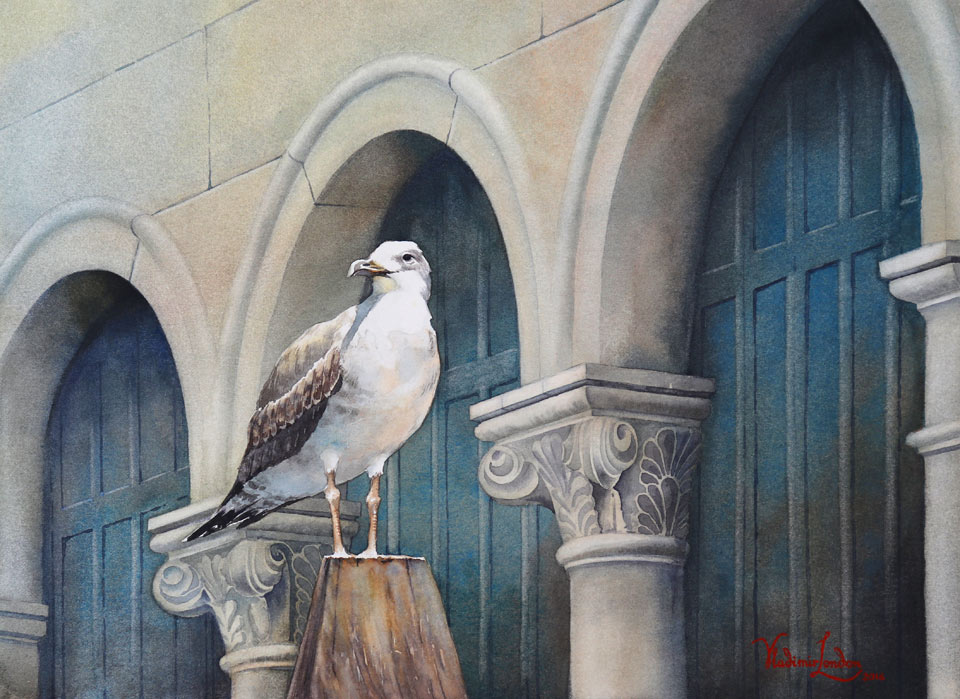
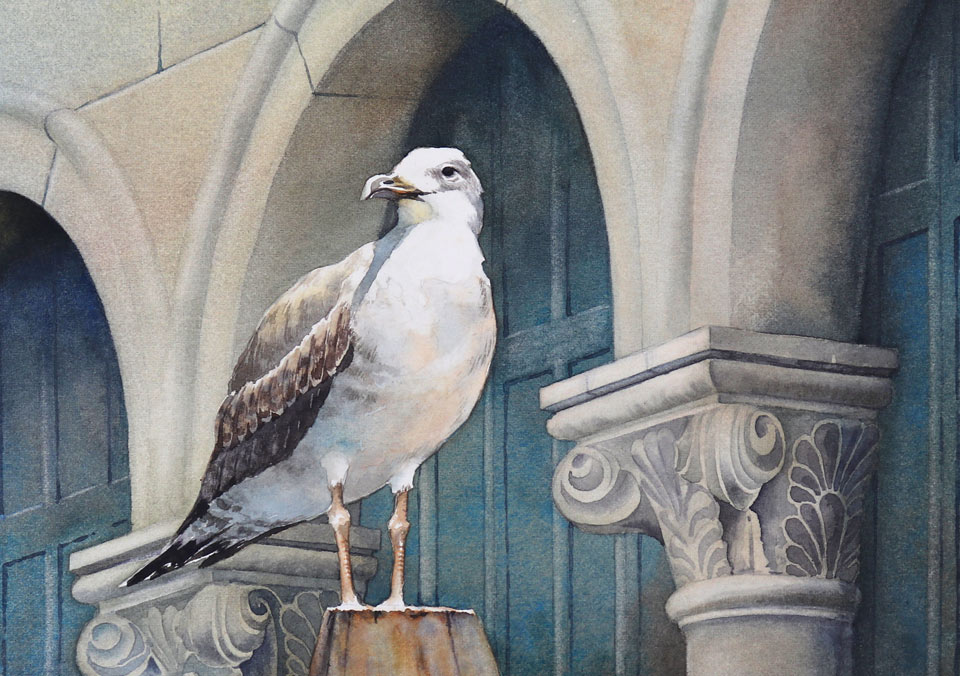
The inspiration for this artwork is taken from Venice, Italy, where you can find a lot of seagulls that nest along the canals, of which there are plenty in this city. Here is one such bird resting on the wooden pole.
Let's begin with transferring the drawing onto the watercolor paper. This drawing has been made on the tracing paper, which is fixed in place with the masking tape. Graphite pencil marks are on the reverse side of the tracing paper. I repeat every stroke with a pen, so that the graphite marks are transferred onto the white watercolor paper. This is a rather mechanical task; all you need to do is to ensure that every single line is outlined once again. For the first wash, I will be using a Princeton Neptune round synthetic squirrel brush (number 8). On the palette, I have mixed three colors – olive green, blue and yellow – to achieve a cold blue-green mix. Since I am making a variegated wash, instead of using just one mixed color, I will introduce several colors into this wash, such as blue and green. For now, it doesn't really matter where one color ends and another begins. All I need at this point is a random gradation between colors. The board with paper attached to it is not horizontal, but tilted at about 15 degrees. That is why paint flows downward and collects into beads without running down in streams. I didn't use any masking fluid to mask the bird; instead, I am going around the bird, leaving its silhouette untouched. Also, it is very important to keep an eye on the bead; as long as the paint is wet, I can continue doing the wash without any sharp borders between brushstrokes.
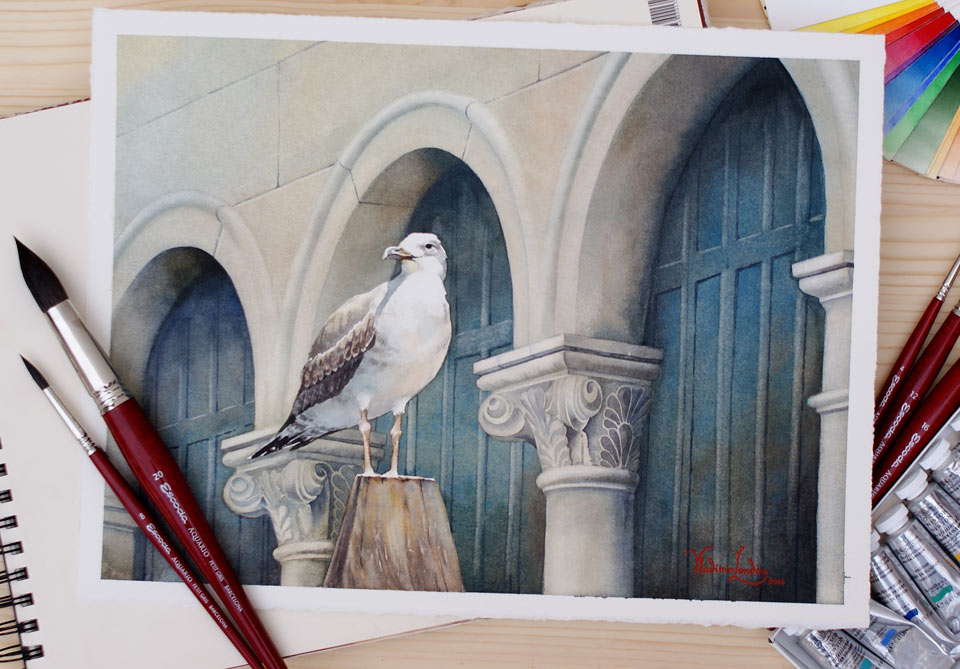
So far, the background has no details whatsoever. It may not look very appealing at this point, and this is fine – all I want to achieve with this wash is to separate the background from the bird and the wooden pole. Towards the bottom part of this artwork, I use a slightly darker and stronger color, which suggests that this part is closer to the ground. While the paper is still wet, I can wipe off paint with the Aqua Elite synthetic Kolinsky brush, which holds its shape very well, and does the job perfectly. Wiping off produces softer edges than with the masking technique. The first wash was done on dry paper. I now want to make a second coat wet-into-wet. Therefore, I apply clean water first using the flat wash brush. The purpose of this layer is to warm up the background, using a mix of yellow and orange pigments. I am using a Princeton synthetic squirrel brush, which holds and releases paint very well. Once again, I am using darker colors closer to the ground.
The area inside the arch is in shadow. That is why I apply darker tones in this area. The reflected light from the ground has a warmer color, so I add earth pigments into the variegated wash. Closer to the ground, this area is in shadow; and I use colder and darker colors to suggest this shadow. One color flows into another and the gradient is soft and natural. When the paper dries, tonal values become lighter. This is because pigment particles sink into the paper fibers.
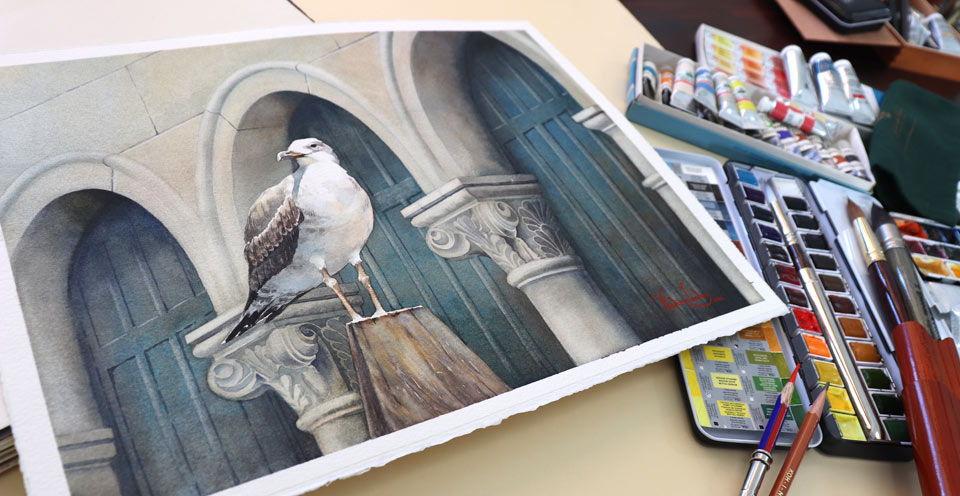
In the watercolor medium, tonal values are more important than colors. As long as you apply tonal values correctly, the artwork will look believable. The variegated wash painting method is a great way to paint wet-on-dry. I can make a sharp border between dry and wet areas, and very soft gradations of colors within the wet area. This is very helpful when I need to preserve white paper, like in the example of leaving the bird untouched.
I am painting in layers. Alternatively, it is totally possible to paint in just one layer – such a technique is called alla prima, which means 'painting in one attempt'. Alla prima is a great technique if you want an artwork to be done fast. The downside is, it is not always possible to achieve the results you may desire. The creative task I have in mind is to get a very rich and textured background, which is simply not possible to make in alla prima. That is why I will make several layers of translucent coats of paint, to build up tonal values and necessary colors gradually. I will show you once again the finished artwork, just to demonstrate that such effects are simply not obtainable in one layer of paint.
Let's return to painting. I wet the paper with clean water using a flat synthetic brush. When the paper is wet, it is easier to add in a casted shadow that will blend in without sharp borders. After big area washes, it is time to start working on smaller details. For this purpose, I am using the Aqua Elite round synthetic Kolinksy brush from the Princeton Artist Brush Company. When precision is required, this is the brush for the job. Its hair not only looks like Kolinsky, but it performs like it too. With the same water capacity, snap, paint release, touch and feel, this is a great replacement for its natural-hair counterpart. Also, the handle of this brush has a velvety charcoal color surface. I really love how it feels in my hand. The small flat brush is another great tool for making thin precise lines.
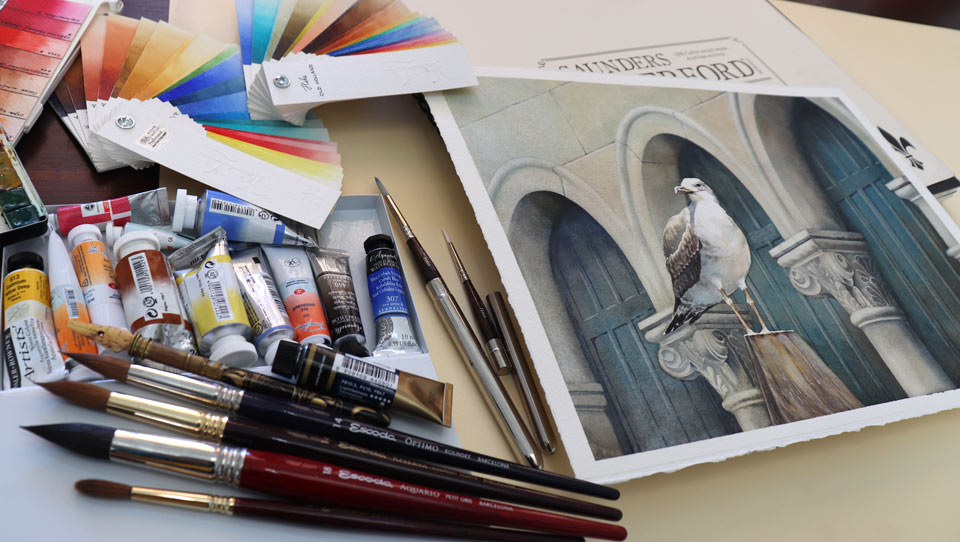
I am washing out pigment off the white paper, in order to make highlights. The synthetic hair of this paintbrush has a perfect snap, which makes it a great tool for this job. First, I wet the paper with clean water and then wash out the paint to almost white paper. This brush is also ideal for modelling delicate shadows in small areas. For small details, which require precision, I am now using the Elite brush number 4. This brush has a very controllable paint realise, and it is really enjoyable to paint with this. The decoration on the column capital has an organic motif. The tonal values of this decoration are influenced not only by light and shadow, but also by some dirt which has accumulated on the column for many centuries.
It's now time to take care of the bird. Seagulls do not have multicolored plumage – they are mostly white with some dark feathers on their wings, tails, and sometimes on their heads. Nevertheless, even a pure white object would never be totally white in watercolor. A three-dimensional object always has light, mid-tones, and shadow areas. Sunshine colors the light areas in yellow, whereas the shadow, together with reflected light, will be colder and can be painted with blue colors. I use the small round brush for painting small details of the seagull's feathers. Dark sports are added wet-into-wet. Before the paper dries, these spots will expand and diffuse a little bit. Also, when the paint dries, it will look lighter. Once again, I am not using the alla prima painting technique, but I am painting the bird in layers, to achieve a richer texture and a similar appearance to the rest of the painting, which is done in multiple glazing layers. The small number 4 round brush is perfect for depicting small details of the bird's feathers.
The paint looks almost black, but is in fact a mixture of the violet and sepia pigments. I never use black paint in watercolor artworks. There are two reasons for this. Firstly, black paint looks dull and uninteresting, and can spoil the appearance of an artwork. Secondly, black colors always look better when created by mixing dark colors. A dark mix of different colors looks more natural in watercolor than a pure black pigment. Here is another tip for using colors: always look for warm colors in cold colored objects or areas of cold colors, and vice versa, it is good to see cold colors in warm colored objects, and add them in watercolor painting. I am now using even smaller Elite round brush (number 3). It is an ideal tool for tiny details. What I like about Princeton synthetic brushes is that they not only look like the natural hair brushes, but also feel like Kolinsky Sable.
The bird's plumage is taking shape. Seagulls are very adaptive, and often successfully co-exist with humans. Venice is located on the sea, and it is not surprising that there are so many seagulls in this city. The seagull's eye is probably the darkest dot in this watercolor artwork. Nevertheless, I am not using a black paint to mark the eye; instead, I mix two pigments – violet and sepia – to achieve a very dark, almost black, color. Sepia and other earth pigments were also used in the seagull's feathers. The casted shadow from the bird's beak has cool color. This is because the warm sunlight is replaced by the reflected light, and this reflected light is blueish because the daytime sky is blue. The bird's breast, however, has some yellowish warm colors. This is because the orangey brown color of the wooden pole is reflected on the bird.
I am using the variegated wash painting technique, applying wet paint on dry paper. I premix several colors on the palette and place them next to each other on paper, so that the paint flows and intermixes, forming different colors between each other. This is only possible while the wash is still wet. Also, I leave some white spots unpainted. Such voids with sharp edges would be very difficult to achieve by washing out, or wiping off paint. It is faster and easier to paint around white spots, rather than preserve white paper using masking fluid. Before this first wash dries, I add darker spots to suggest a wooden texture. The dark color used here is a mix of violet paint with sepia. When it mixes with the orangey brown wash on paper, this color becomes brown, like old wood.
A self-study, self-paced course where you can learn how to paint in watercolor by watching video lessons and doing assignments
One-time payment - Lifetime membership
$297 USD
One-to-one, unlimited and custom-tailored to your skills and needs Personal Tutoring by the Watercolor Academy teachers
One-time payment - Lifetime membership
$997 USD